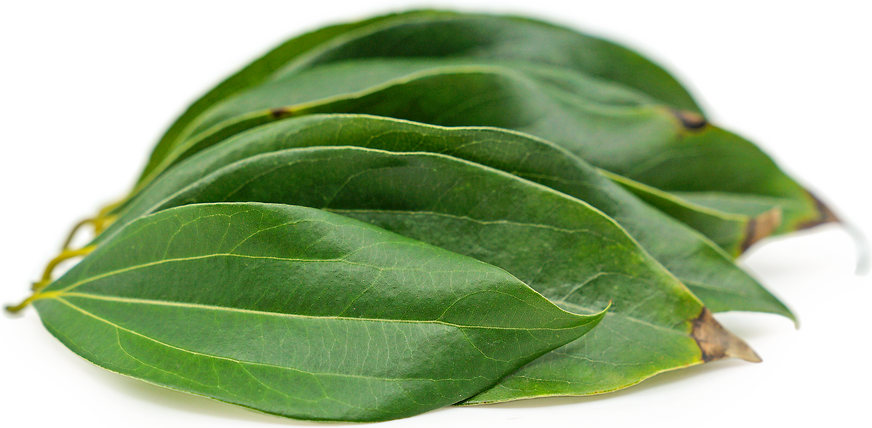


Cinnamon Leaves
Estimated Inventory, lb : 0
Description/Taste
Cinnamon leaves are medium in size and are elongated, slender, oval to lanceolate in shape, and tapers to a point. The surface of the leaf is leathery and shiny green when fresh, and there is a prominent central light green vein that runs through the center of each leaf. Immature Cinnamon leaves are red before they mature to their bright green. They grow on smooth branches, and the tree is also known for its thick bark. Cinnamon leaves are often dried and have a lighter taste and aroma compared to cinnamon bark when used in teas or cooking. Dried Cinnamon leaves have a matte finish and become olive in color, resembling bay leaves, and have a spicy, pungent taste.
Seasons/Availability
Cinnamon leaves are available year-round.
Current Facts
Cinnamon leaves, botanically classified as Cinnamonum verum, grow on an evergreen tree that thrives in tropical climates reaching up to twenty meters in height and are members of the Lauraceae family. Also known as Indian bay leaf, Cassia leaf, or Tej Patta, there are over one hundred varieties of "true cinnamon" with two varieties being the most widely consumed: Ceylon cinnamon and Chinese cinnamon. Historically, the leaves were distilled into a light-yellow oil and used for medicinal aromatherapy purposes and as a scent in perfumes. The leaf oil has a powerful, spicy, and musky aroma with strong notes of clove and citrus. Cinnamon oil has been embraced by many cultures for its warming, stimulating effects on the body and the spice cinnamon was at one point in history more expensive than gold.
Nutritional Value
Cinnamon leaf oil is rich in phytonutrients and contains eugenol, which may help with gastrointestinal problems including stomach aches, nausea, and diarrhea. It also has high concentrations of cinnamaldehyde, which is a natural pain reliever with anti-inflammatory properties.
Applications
Cinnamon leaves are most commonly used in a dried state and should be removed from the dish before consuming. They are used to flavor stews, pilafs, and curries, and dried Cinnamon leaves can often be substituted for bay leaves in many recipes. In Jamaica, Cinnamon leaves are traditionally used to flavor cornmeal porridge and jerk marinades. Cinnamon leaves are also used as a flavoring agent for baked goods and desserts. In addition to cooking, the leaves are commonly boiled and made into an herbal tea. Cinnamon leaves pair well with cloves, green cardamom, black pepper, coconut milk, pork, chicken, and lamb. Dried Cinnamon leaves will keep up to six months when stored in an airtight container in a cool, dry, and dark place.
Ethnic/Cultural Info
In Egypt, Cinnamon leaves and oil were extremely popular and were used for their aroma and energizing properties as early as 2,000 BCE. They were mainly used as an anointing oil, perfume, incense, and even fragrances for the embalming process. Today Cinnamon leaf oil is also used to help reduce symptoms of general aches and pain, arthritis, and to help with digestion.
Geography/History
Cinnamon leaves have been around since ancient times, and the exact origin is largely unknown. They are believed to be native to Burma, Sri Lanka, Bangladesh, and the Malabar coast of India and were then spread by Arab traders to Babylon, Egypt, Rome, and the rest of Europe. Today Cinnamon leaves can be found fresh at specialty markets in India, Sri Lanka, Bangladesh, Burma, China, Vietnam, Madagascar, Comoros Islands, South America and the West Indies. It can also be found in dried form and as an oil extract on online retailers in the United States and Europe.
Recipe Ideas
Recipes that include Cinnamon Leaves. One
| NY Times |
|
Cinnamon Lamb Curry |
| Dassana's Veg Recipes |
|
Dal Makhani |
| Dassana's Veg Recipes |
|
Paneer Butter Masala |




